
| Palaeos: Mesozoic |  |
Late Triassic epoch |
| Triassic Period | Carnian Age - 3 |
| Page Back | Back: Ladinian | Back: Middle Triassic | Up: Carnian 1 | Unit Home |
| Page Next | Next: Norian | Next: Early Jurassic | Timescale |
| Mesozoic Era
Triassic Period Early Triassic Epoch Middle Triassic Epoch Anisian Age Ladinian Age Late Triassic Epoch Carnian Age Norian Age Rhaetian Age Jurassic Period Cretaceous Period |
Introduction
The Geography of the Carnian The Climate of the Carnian Stratigraphy Plants Invertebrates Tetrapods - Land Faunal Stages A Carnian Bestiary Links |
Pelorocephalus | Metoposaurus | Leptopleuron | Shonisaurus | Henodus | Brachyrhinodon | Malerisaurus | Trilophosaurus | Hyperodapedon | Paleorhinus/Parasuchus | Angistorhinus | Saurosuchus | Ornithosuchus | Stagonolepis | Postosuchus | Erpetosuchus | Scleromochlus | Pisanosaurus | Herrerasaurus | Saltopus | Placerias and Ischigualastia | Exaeretodon | Microconodon and Dromatherium | Gondwanadon and Adelobasileus
 illustration © Paul E. Olsen, from Lecture 10 - Triassic: Newark, Chinle |
|
Erpetosuchus granti is a small (about 60 cm ion length) crocodylomorph known from four specimens from the latest Carnian Lossiemouth Sandstone Formation [Benton and Walker 2002]. A related but somewhat later (?early to mid
Norian) species has more recently been found in the New Haven Formation of the Newark Supergroup, Connecticut Valley [Olsen et al 2000]. It can be assumed that these little animals had a wide distribution over much of northern Pangea at the time.
References/Links: |
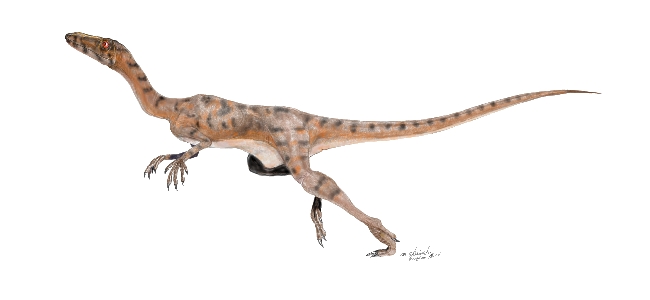 illustration © M. Shiraishi, |
|
Saltopus elginensis is an enigmatic ornithodiran known from a single partial but still fairly complete skeleton from the Lossiemouth Sandstone of Elgin, Scotland. In life, this was a gracile, long-legged cat-sized animal about 60 or 70 cm long, with jaws equipped many small sharp teeth indicating a mostly insectivorous diet (although microvertebrates were also on the menu).
References/Links: |
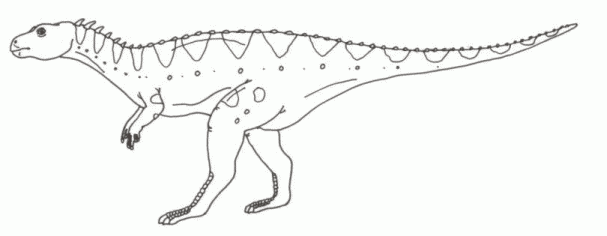 drawing © 2001 Vince R Ward - Prehistoric Pages |
|
Pisanosaurus is a small dinosaur, about a meter in length, known from a single partial skeleton from the Ischigualasto Formation, San Juan Province, Argentina. One of the earliest known and most primitive of the ornithischian dinosaurs (Order Ornithischia), it is usually included under the family Fabrosauridae (a mostly early Jurassic group best known from South Africa) but is too poorly known to be place
there with any certainty. The Fabrosauridae in fact are something of a garbage taxon for any basal or very primitive ornithischian dinosaurs.
|
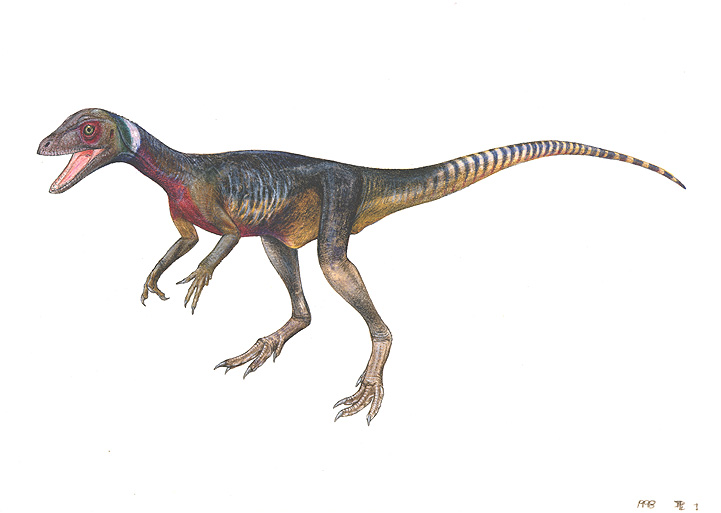 illustration © Seiji Yamamoto |
|
Herrerasaurus ishigualastensis, known from the Ischigualasto Formation, San Juan Province, Argentina (Southwest Pangea), is a very primitive and early member of the theropod dinosaur clade, and the eponymous representative of the family Herrerasauridae. Since Herrerasaurus was found, other herrerasaurs have turned up or been relocated in this group. These include Staurikosaurus from the (slightly earlier?) Santa Maria Formation, Brazil, which Paul 1988 considers a more primitive animal, the Norian Chindesaurus, and the poorly known Caseosaurus, the two latter from North America. At one time it was thought that the herrerasaurs lay outside the rest of the dinosaur lineage [Benton 1990], but they were later (following publication of several papers by Sereno and Novas) considered pre-ceratosaurian theropods proper. These were all medium to large and active terrestrial carnivores, which were distinguished from the contemporary rauisuchians by their efficient bird-like digitigrade (standing on toes) stance. Herrerasaurus was one of the largest Carnian dinosaurs, with an estimated overall length of around 3.9 metres, and an adult weight of about 210 kg [Paul 1988]. Yet both early dinosaurs and pseudosuchians (Ornithosuchids, rauisuchids, and poposaurids) co-existed happily for many millions of years. It is likely that the slower and more heavily built pseudosuchians were ambush predators that fed on large or slow animals; and the more lightly built and fast-running herrerasaurs and Coelophysids were pursuit predators of small to medium-sized animals |
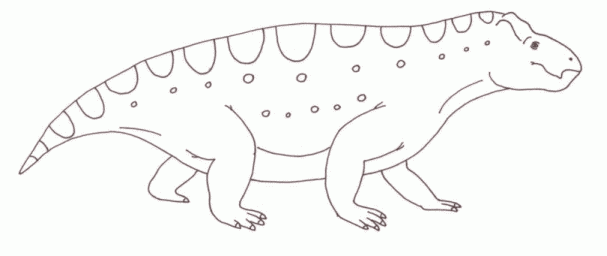 drawing © 2001 Vince R Ward - Prehistoric Pages |
|
During the Late Carnian, the megaherbivore niche was still dominated by large
kanneymeriid
dicynodonts, as it had been throughout almost the entire Triassic (from the Olenekian age onwards). And although by the late Carnian they were still common, they were reduced in diversity, with only one species found in each local fauna. The best known species are Placerias hesternus (= Placerias gigas) of the Chinle Formation, Arizona, and south in the Ischigualasto local fauna of Argentina, has been found the related Ischigualastia jenseni (known only from the Lower Third of the Ischigualasto Formation [Bonaparte, 1970]). both members of the placerine tribe. Placerias is also reported from Morocco (which shares a number of points of similarity with the west North America fauna), and a "large dicynodont" is described from
India [Lucas 1998].
References/Links:
|
 Illustration from The Cambridge Encyclopedia of Life Sciences, ed. Adrian Friday & David S. Ingram, © Cambridge University Press 1985. |
|
One of the most common animals of the Carnian age was the large herbivorous
traversodontid cynodonts
of the genus Exaeretodon; known from the Gondwanan biogeographic province (Argentina, Brazil, India, and more recently [Depuydt 1998] Madagascar; with smaller and more distantly related forms from western Laurasia). These were the largest of the Traversodontidae, reaching nearly 2 meters in length, and probably weighing around 80 kilos live. They were also among the most mammalian
of the group, with a mammalian hip indicating a more erect posture and limbs under the body; possibly also some steps towards coupling of locomotion and breathing [Hunt 1994-1997].
List of species:
|
 Microconodon tooth © Natural Canvas Fossils |
|
Dromatherium sylvestre and Microconodon tenuirostris were tiny rat or shrew-like animals known from a few jaws and teeth from the Latest Carnian (Adamanian stage) of the Newark Supergroup of Eastern North America (North Carolina, Virginia, and Pennsylvania). Originally (during the 19th
century) considered among the earliest and most primitive mammals, they were reinterpreted in the 1920s by G.G. Simpson. Their several supposedly unique mammalian features are shared by tritheledontids and other advanced cynodonts, and they are now best regarded as advanced or derived eucynodonts of uncertain affinities. [Sues 2001] A
dromatherid has been reported from the Tiki Formation, India, and several problematic taxa known only from isolated teeth from the Late Triassic and Early Jurassic of Europe are also usually placed in the Dromatheridae [Luo et al 2002]
|
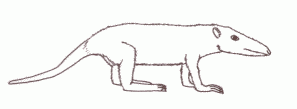 drawing © 2001 Vince R Ward - Prehistoric Pages |
|
Adelobasileus cromptoni, known from a partial skull from the Latest Carnian (Adamanian) Tecovas Formation, West Texas, USA, is the most primitive and perhaps the earliest known mammal, intermediate condition between non-mammalian cynodonts and true Early Jurassic mammals. It also predates the earliest known tritylodontids and trithelodontids, unless the partial
dentary called Pachygenelus milleri, from the contemporary (or earlier?) strata of the Dockum Formation, Texas [Chaterjee 1986], turns out to be a genuine trithelodontid. Gondwanadon tapani from the Tiki Formation, South Rewa Gondwana basin, Madhya Pradesh, India (?early Late Carnian). Claimed to be the earliest mammal, this specimen is based on a single tiny molar. Its attribution as a
morganucodontid is very dubious, but it does seem to indicate that as early as the late Carnian there were tiny animals on the borderline between reptile and mammal scurrying through the undergrowth or in trees. The name means "Gondwana tooth". Exact systematical relationships of both these tiny animals are uncertain.
|
| Page Back | Unit Home | Page Up | Page Top | Page Next |

Except for material otherwise attributed or quoted, all text on this page is licensed under a
Creative Commons License.
Apart from menu header and other images by MAK or ATW, and public domain gifs, all images on this page are not covered by this
license,
and are copyright their respective owner or publisher.